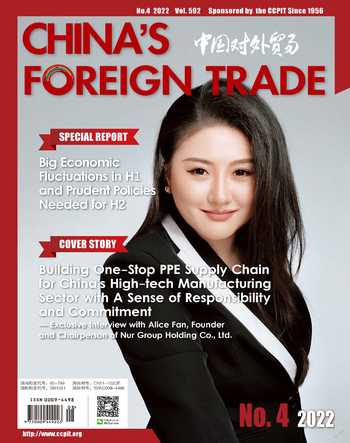Prospects for the Export of Chinese Cars to Russia
By Allen Zhang
Under the influence of the recent geopolitical conflict, the EU launched a fourth round of sanctions against Russia, including export restrictions for limousines to Russia. In the face of multinational auto brands companies reducing their exports to the Russian market, the Minister of Industry and Trade of the Russian Federation Denis Manturov recently publicly stated that the Russian Ministry of Industry and Trade is discussing the possibility of seeking alternatives with Chinese auto manufacturers. Against this background, Andrei Olkhovsky, the general manager of GC Avtodom Group, a Russian car sales and service provider, was exclusively interviewed by China Foreign Trade.
“The sanctions taken by Western countries have greatly reduced the number of cars exported to Russia, and the structure of the Russian car market is changing rapidly. Nevertheless, Russia and China maintain stable economic and trade ties. The two sides have great potential for cooperation in the field of auto trade, and are now ushering in special development opportunities,” explained Andrei Olkhovsky.
The 27,761 new cars and light commercial vehicles (LCV) sold in Russia in June 2022 represented a decrease of 82.0% compared to the same month in 2021 in light of the Russia-Ukraine war according to the Association of European Business (AEB) Automobile Manufacturers Committee, a group representing foreign investors in Russia.
Domestic car models like the AvtoVAZ-owned Lada — an icon of Sovietera self-reliance — could, in theory, stand to benefit from the absence of foreign competition. However, sanctions have snarled supply chains, leading to a severe parts shortage.
According to Andrei Olkhovskys introduction, due to the sanctions, the supply of auto products to Russia through official channels has almost stopped, causing the Russian auto market to struggle. “Currently, only Chinese and some Korean automakers can continue to deliver. New cars from European brands are only present at some dealers, but this inventory can only meet the demand for merely 4-6 months,” he added.
Is this an opening for Chinese companies? It is indubitable that China and Russia have developed a unique model of interstate trade in the form of a profitable and promising relationship in recent years. Contacts in all areas have intensified between China and Russia, including at the highest state level.
Unexpectedly, although Chinese brand cars have been widely favored in the Russian market in recent years, their market share is not large. “In contrast, German, Japanese and Korean brands have long held a strong market share advantage due to their large production capacity in Russia and their high brand recognition,” said Andrei Olkhovsky.
However, that appears to be changing: “Under the current situation, several American, European and Japanese car brands may withdraw from the Russian market, which may lead to a further increase in the share of Chinese brands in the Russian market. The number of cooperative resellers will also increase accordingly. This will not only mean that car companies from China will have a stronger position in the Russian market, but that Russians will also see more new brands from China,” continued Andrei Olhovsky.
According to data released by Chinas General Administration of Customs, China-Russia bilateral trade stood at USD 65.81 billion in the first five months, up 28.9 percent on a yearly basis. The growth rate accelerated from the 25.9 percent seen in the January-April period. The volume of goods traffic demonstrates significant growth dynamics. This also applies to mutual exports and imports from China to Russia. The share of settlements in RMB when working with Russian partners is also increasing against this backdrop.
“In the auto area, Chinese brands will no doubt see the current situation as an opportunity and there is a chance more will look to establish a Russian production base in the future,” said Andrei Olkhovsky.
Based on business reports, Chinas Great Wall Motors and Geely saw strong growth in sales in Russia over the first quarter as a whole, and suffered narrower losses than their Western rivals in March.
At the same time, there is a shortage of new cars all over the world, so not only Russia is interested in products from China. According to the China Association of Automobile Manufacturers, In the first half of 2022, Chinas automobile export volume surged, reaching 1,218,137, up 47.12% year on year. Among these, 202,000 new energy vehicles were exported, up 1.3 times year on year, accounting for 16.6% of the total automobile export volume. That puts China on track to overtake Germany and become the worlds second-largest auto exporter after Japan.
Established in December 1992, GC Avtodom Group is currently one of the largest car sales and service providers in Russia. Its business mainly focuses on the sales and service of premium cars and luxury cars. It has previously established itself as a reliable partner for many European car brands in Russia.
GC Avtodom is also interested in providing more support for Chinese cars in the Russian market. Andrei Olhovsky said: “Although there are many uncertainties in the future of the Russian car market, we are still willing to talk to more partners and try to become an authorized dealer through economic negotiations. Chinese brands we are interested in at the moment include Hongqi, NIO, BYD and SAIC.”
- China’s foreign Trade的其它文章
- Zero Tolerance for Bad Faith Trademarks By Chinese Authorities
- Focus on Seven Aspects of the Amendments to the Anti-Monopoly Law
- Off-shore Duty-free Consumption in Hainan Surges
- New Infrastructure Construction Promotes the Stable Growth of the Chinese Economy
- China’s Automobile Exports Catch Up from Behind
- The Logistics Industry Turns Positive

